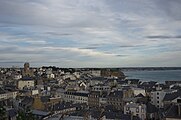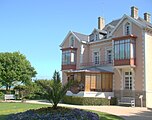Granville (Manche)
| Granville | ||
|---|---|---|

|
|
|
| region | Normandy | |
| Department | Some | |
| Arrondissement | Avranches | |
| Canton | Granville | |
| Community association | Granville, Terre et Mer | |
| Coordinates | 48 ° 50 ′ N , 1 ° 35 ′ W | |
| height | 0-67 m | |
| surface | 9.90 km 2 | |
| Residents | 12,580 (January 1, 2017) | |
| Population density | 1,271 inhabitants / km 2 | |
| Post Code | 50400 | |
| INSEE code | 50218 | |
| Website | www.ville-granville.fr | |
Granville (debate [ɡʁɑ.vil]), Norman Gray Ville ([ɡʁɑɔ.vil]) is a French city with 12,580 inhabitants (at January 1, 2017) in the department of Manche in the region of Normandy with a seaport , a fishing port and a marina with 1100 berths . Granville has been a climatic health resort since 1926 and a seaside resort since 1979.
geography

The city lies on and on a rocky cape in the southwest of the Cotentin peninsula . It consists of the old upper town surrounded by fortress walls ( haute ville ) and the lower town ( basse ville ).
history
The city owes its name to the noble Grant family . In the 11th century they received possessions in Normandy from William the Conqueror as thanks for support in war deals. In 1230, due to the lack of male descendants of the Grant family, the town became the property of the Argouges family. The churches and monasteries on Mont-Saint-Michel were built from granite that comes from the Granville quarries. In the 14th century, the Kingdom of England conquered all of Normandy with the exception of Mont-Saint-Michel. The English besieged this from the port of Genêts .
At the beginning of the 14th century, Genêts was no longer safe enough. Sir Thomas Scalles bought the Lihou rock, the name of the place at that time, from Jean d'Argouges and built a fortress on the Feldberg. At the foot of the cliffs he also had a trench seven meters wide and eighteen meters deep dug, which the sea water filled. Granville thus became an island, larger than Mont-Saint-Michel. In 1442, however, the defenders of Mont-Saint-Michel captured Granville and expelled the English once and for all. King Charles VII recognized the strategic importance of the place, had it expanded into a fortified city, ordered the creation of a coat of arms and levied taxes on the residents.
In 1492 Jews expelled from Spain came to Granville. Since they were forbidden to live in the center of the city, they settled on the outskirts. They were allowed to lend money and forge gold jewelry. Their activities contributed to the development and growth of the city. Gradually Granville developed into a major port for the cod fishing industry. The city's ships, 70 to 80 in number, had the right to arm themselves. The city produced around 15 admirals, including Georges-René Pléville Le Pelley , the corsair with the wooden leg . Beaubriand Lévesque and Hautmesnil-Hugon were two other corsairs from Granville; the statues of the three look over the present port of the city.
Under Louis XIII. (King from 1610 to 1643) the walls were reinforced to accommodate the advances in artillery technology. The eastern port was moved to the south. Today this is the great port, protected on its left by the main bastion.
The Marquis de Louvois , Louis XIV's Minister of War , had the walls razed in 1688 because he was of the opinion that they could not withstand an attack by the English from the sea and an attack by the Protestants from land. In 1692 the English actually shot at the city with their artillery. 80 houses were hit, 27 of them destroyed. In 1793 troops of the Vendée uprising attacked the city, whose harbor was only poorly protected by palisades and an earth wall. When the soldiers were preparing to occupy the harbor, women from the upper town threw cider barrels at them and withdrew.
The current, austere-looking residential building architecture in the Upper Town dates from the 18th and 19th centuries. From the middle of the 19th century, Granville developed into a seaside resort . Since then, bathing tourism has shaped urban life in the summer months. Stendhal , Jules Michelet and Victor Hugo were in Granville. The investor Frank Jay Gould wanted to make Granville the “Monaco of the North” and in 1911 he built a casino and in 1912 the hotel palace le Normandy.
In June 1940, the place - like all of northern France - was occupied by units of the Wehrmacht as part of the western campaign . After the invasion of Normandy (from June 6, 1944, D-Day) Granville was evacuated by the German troops on July 31, 1944 without a fight. On September 1, 1944, the SHAEF began operations near Granville; but after about two weeks it already moved to be closer to the rapidly advancing front. On March 9, 1945 there was a coup d'état on Granville, which lasted about 1.5 hours, by a German commando group coming from the island of Jersey . The soldiers came because they couldn't get any more supplies.
Attractions
- The Notre-Dame du Cap Lihou church dates from the 15th century, the facade was renewed in the 17th and 18th centuries.
- The Point du Roc is a lookout point on the small island group Îles Chausey . It's on the western end of the rocks near the lighthouse.
- The aquarium with a mineral and shell art collection.
- The Musée du Vieux Granville displays old documents and objects of the city as well as Norman costumes.
- The Musée Christian Dior in the former villa of the fashion designer shows his original creations from different periods of life, some of which were worn by famous personalities, as well as other memorabilia from his life. Entry to the surrounding park, richly decorated with flowers and ornamental plants, is free. The house and garden located above a cliff offer a beautiful view of the sea, the beaches and the upper town of Granville and the Chausey Islands.
economy
Granville is a traditional fishing port. In the meantime, however, tourism has become the city's most important industry.
traffic
The Gare Maritime has daily connections to the Channel Islands of Jersey and Guernsey and to the Chausey Islands.
Granville is directly accessible by train from Paris Gare Montparnasse .
Town twinning
In 1989, through the partnership between Granville and Sherborne in Great Britain, the European association of towns and cities Douzelage was created . One city from each state of the European Union is a member of this association.
Granville is also twinned with Saint Brélade in Jersey .
tourism
Granville is a popular seaside resort that gets crowded in high season. Outside the season, however, you can find peace and quiet on the varied sandy and rocky beaches and strolls along the walls and in the alleys of the upper town.
The town has a casino on the main beach. It is also a center for thalasso therapy .
Personalities
- Étienne-François Le Tourneur (1751–1817), military and politician
- Fortuné du Boisgobey (1821-1891), writer
- Léon Herpin (1841–1880), painter
- Désiré Georges Jean Marie Bois (1856–1946), botanist
- Maurice Denis (1870–1943), painter
- Christian Dior (1905–1957), fashion designer
- André Bonin (1909–1998), fencer
- Pierre Pican SDB (1935–2018), religious priest and Roman Catholic bishop
- Jacques Gamblin (born 1957), actor
- Myrtille Georges (* 1990), tennis player
Web links
Individual evidence
- ↑ The illustration follows the page of the city of Granville on its history ( memento of January 8, 2010 in the Internet Archive ), visited on June 18, 2009.
- ^ Martin Blumenson: Breakout and Pursuit (US Army in World War II: The European Theater of Operations). Center of Military History, Washington, DC 1961, chap. 32: Towards the Heart of Germany: Broad Front versus Narrow , p. 684 (website of the HyperWar Foundation , English).
- ↑ Der Spiegel 46/1965



